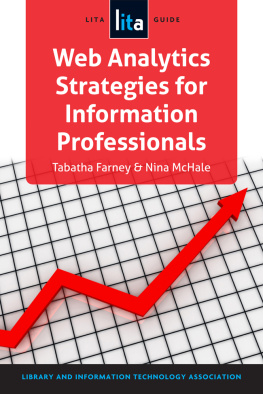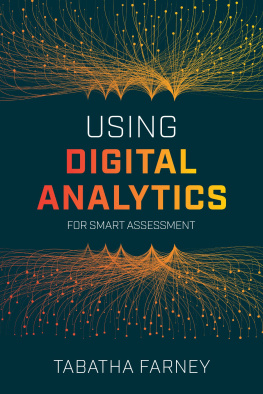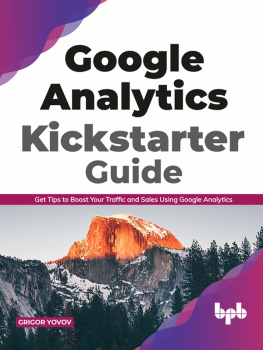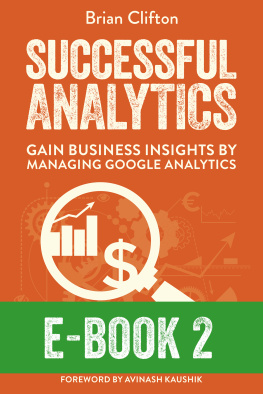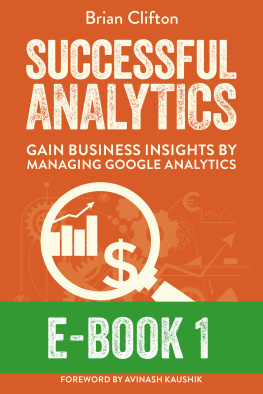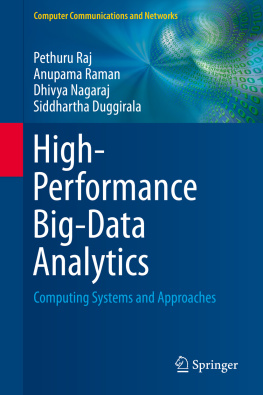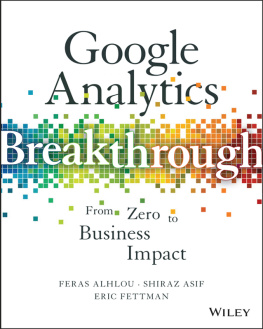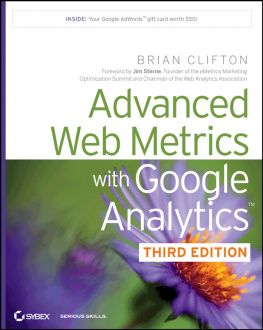Web Analytics Strategies for Information Professionals
ALA TechSource purchases fund advocacy, awareness, and accreditation programs for library professionals worldwide.

Web Analytics Strategies for Information Professionals
A LITA Guide
Tabatha Farney and Nina McHale

An imprint of the American Library Association
CHICAGO 2013
2013 by the American Library Association. Any claim of copyright is subject to applicable limitations and exceptions, such as rights of fair use and library copying pursuant to Sections 107 and 108 of the U.S. Copyright Act. No copyright is claimed for content in the public domain, such as works of the U.S. government.
Extensive effort has gone into ensuring the reliability of the information in this book; however, the publisher makes no warranty, express or implied, with respect to the material contained herein.
ISBNs: 978-1-55570-897-9 (paper); 978-1-55570-954-9 (PDF); 978-1-55570-955-6 (ePub); 978-1-55570-956-3 (Kindle). For more information on digital formats, visit the ALA Store at alastore.ala.org and select eEditions.
Library of Congress Cataloging-in-Publication Data
Farney, Tabatha.
Web analytics strategies for information professionals : a LITA guide / Tabatha Farney and Nina McHale.
pages cm. (LITA guide)
Includes .
ISBN 978-1-55570-897-9 (alk. paper)
1. Library Web sitesManagement. 2. Library Web sitesStatistical methods. 3. Web usage mining. 4. Library statistics. I. McHale, Nina. II. Library and Information Technology Association (U.S.) III. Title.
Z674.75.W67F37 2013
025.17'4dc23 2012044515
Cover image roopert/Shutterstock. Inc.
Contents
Tabatha Farney and Nina McHale
Joelle Pitts and Tara L. Coleman
Harriett E. Green, Jordan Ruud, and Andrew Walsh
Christopher C. Brown
Junior Tidal
Appendixes
A s libraries continue to forge ahead into the brave new digital world, tracking usage in our digital spaces is becoming increasingly important. Library staff have long kept statistics of usage of physical resources, such as gate counts, reference and circulations transactions, and shelving and reshelving statistics. Many a paper tally sheet has been used to compile a report for administration to provide a day-to-day snapshot of how users interact with library resources and services. The same holds true in the digital realm, and for the same reasons: at assessment time, managers need to account for resources allocated, and directors need big-picture information to share with their superiors and stakeholders to justify continued funding and support for library resources and services. Knowing which online resources, whether locally created or licensed from vendors, are highly usedand which are notcan help project managers and administrators make important decisions about precious resources, especially staff time and training.
The web analytics guru Avinash Kaushik likens the analysis of web statistics to the reading of tea leaves: its not a precise science, but one can detect and track general patterns that are informative and enlightening. Kaushik (2010) provides an overview of web analytics and lays out the framework for commercial organizations to effectively analyze their web statistics. This LITA guide differs from Kaushiks contributions, however, in that it focuses on web analytics in the library world. Understanding customer behavior is critical in the world of online commerce, but the same holds true in library web environments. Other nonprofit-based organizations can also refer to this book, as it focuses on using web analytics for noncommerce websites. Additionally, since this book focuses on libraries that seldom have budgets for commercial web analytics tools that businesses can afford, we focus primarily on free or low-cost tools like Google Analytics, Piwik, and AWStats. Although we also discuss other tools, we use these three in the majority of examples.
Once a web analytics tool of choice is in place, a library can collect and harness the data. Web analytics data can reveal how website users find and use a website, basic technological information about the user, what content is being consumed, and trends in user behaviors. Additionally, library staff can craft website related goals and use website statistics to measure the effectiveness of their websites against their goals. All of this data is collected and analyzed automatically, without ever disturbing the website user.
Web statistics arent just for web librarians and developers; they can inform libraries of online resource usage, peak times of library use, and how website users are actually interacting with the site. These data should interest all areas of the library: technical services can verify which resources visitors use and how they find them, public services can learn which content visitors need, and administrators can better understand the impact of the librarys online services. Web Analytics Strategies for Information Professionals emphasizes the importance not only of collecting and analyzing website use data but also of reporting, sharing, and acting on those data within the library. This book takes readers through a step-by-step process of understanding and using web analytics for libraries with examples of how libraries can turn data into actions.
ORGANIZATION
, Understanding Web Analytics for Libraries, introduces the general concept of web analytics. A detailed look at how libraries can use analytics follows, as well as some pro tips for beginners. Next is a look at which data are actually captured by statistics-gathering web analytics tools, and how individual data points can be used to create bigger pictures of web use. Analytics is not without its unique set of challenges, however, so the first chapter concludes with the caveats and a description of shortcomings in analytics tools and practices.
, Talking the Talk: Web Analytics Terms and Definitions, demystifies the terminology commonly used by web analytics tools, singling out which are particularly of interest to libraries and information centers. This chapter explains basic concepts, such as visits, visitors, traffic sources and referrers, landing and exit pages, and bounce rate, in addition to more advanced web analytics concepts, like conversion and key performance indicators. Web analytics tools provide detailed information on who comes to the site, where they have come from, how long they stay, and where they go while they are on the site.
In , Selecting and Evaluating a Web Analytics Tool, we take a closer look at available analytics tools. Google Analytics is wildly popular in library circlesand it is the most likely to integrate with a catalog, content management system, or other online toolbut it is by no means the only option. There are several commercial and open-source offerings from which to choose; some of them are hosted by the vendor, and others are installed locally on the web server. As with any software products, the features and reporting differ widely as well. The chapter also offers an overview of planning for statistics-tracking software, with tips on planning usage, budgeting for tools and staff time to implement, getting support, and testing.
, Creating Customized Web Analytics Reports for Libraries, introduces core concepts in web analytics to help libraries go beyond using standard data reports. In this chapter, youll learn how to efficiently segment data to analyze specific user groups and create customizable reports tailored to your librarys needs. The chapter discusses several highly useful reports and demonstrates how libraries can use them.
Next page
